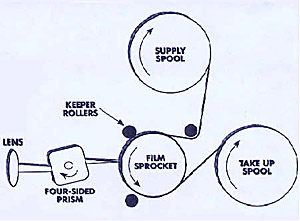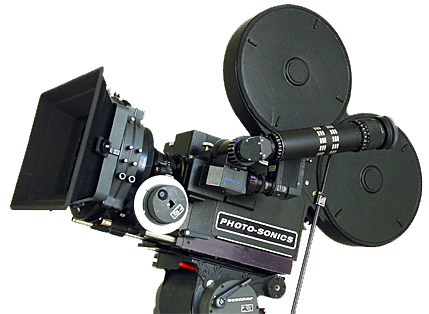|
|
||||||
|
The
Tools and Techniques |
||||||
|
||||||
|
Today’s cinematographers rely on two basic types of cameras for their high-speed work—pin-registered and rotary prism cameras. One of the two, the pin-registered cameras care the most common. Their appeal lies in their rock-steady registration and superior image quality. The limiting factor of pin-registered cameras, however, is frame rate. For example, the 35mm-4ER Photo-Sonics camera is limited to a maximum frame rate of 360 frames per second. The 16mm Photo-Sonics Actionmaster 500 is limited to a maximum frame rate of 500 frames per second. If your shot requires a faster camera, you must then use a rotary prism camera. At Photo-Sonics, we supply a 35mm 4C rotary prism camera that runs up to 2,500 frames per second, as well as a 16mm E10 rotary prism camera that runs up to 10,000 frames per second. |
||||||
|
|
Typically,
pin-registered high-speed cameras are used for filming slow-motion
sequences involving liquid pours, splashing liquids, cereal pours,
large explosion effects, car stunts, sports or any type of effect
that may require optical or matte work. The faster rotary prism
cameras are used to shoot such slow-motion scenes as deployment of
vehicle airbags, cereal falling through frame, small-scale explosion
effects, the classic water droplet and crown effect, a close-up of a
golf ball being hit by a golf club, and bullets exiting the barrel
of a gun. The disadvantage of a rotary prism camera is that it produces a slight bit of image bounce and side weave. This effect usually goes unnoticed to all but a trained eye and is almost undetectable if there are no registration points in the frame. For instance, if you are shooting a water droplet hitting the surface of water, you have no distinct reference in frame to reveal the image bounce. Your shot begins on a surface of water with no hard edges or lines. When the droplet enters frame, it is in motion. When it hits the surface of the water, the water is in motion. Therefore, there is nothing in frame that needs to be rock-steady. |
|||||
|
The optical path of a rotary prism camera. |
||||||
| Another example would be an explosion. In most cases, explosion effects are very violent. Flying parts and debris make up the majority of the frame. Therefore, again, there is very little in the frame that would make any reference to camera registration. | ||||||
|
Shutter Speeds
& Exposure Times Because of the need for a longer ratio of film transport time, the majority of 35mm pin-registered high-speed cameras have reduced shutter angle. In the case of the Photo-Sonics 4ER, the shutter angle is 120 degrees. The simplest way to calculate exposure is by using this basic math formula: 360 degrees divided by the usable shutter angle x frame rate = 1/exposure time. This calculation can be used with most motion picture cameras, including rotary prism cameras. But if your camera employs a beam-splitter for reflexing, this also must be compensated for. In most cases, that amounts to 1/2 stop.
The Pin-Registered 4ER Camera A disadvantage of this method is that you lose 1/2 stop of light to the film. An advantage, however, is that you are able to use a shuttered video camera for video assist, which gives you much sharper images. As a result, you can analyze your shots much more accurately. Because fast-moving objects are nearly always shot with this type of camera, the shuttered video tap is an absolute necessity. This method of reflexing is also preferable when shooting high-speed cinematography with Unilux strobes. You only have to flash once per frame. Your film receives 75 percent of the light, and your eye sees 25 percent. Cameras that employ a spinning mirror must flash once for the film and once for the viewing system. A 300-fps spinning mirror camera requires the strobes to run at 600 flashes per second, which substantially reduces the output of the strobe (about two stops). An alternative is the use of a split-sync system, which synchronizes one light head 180 degrees out of phase of the shooting heads. This method’s drawback is that the camera operator and video assist system do not see the actual light that will be exposing the film. Rotary Prism 4C Camera |
||||||
|
|
Keep in mind that both
the four-sided prism and the film are constantly in motion. The
motion is synchronized so that the relative motion between the image
and the film during the exposure phase is zero. Because these
cameras use a wiping effect and have no hard aperture plate, one
frame blends to the next without showing a sharp frame line. Rotary
prism cameras are most often fitted with 72-degree shutters. Reciprocity Failure Most film stocks do not require compensation for reciprocity failure unless the exposure time is less than 1/10,000th of a second. However, because most directors of photography prefer a “thick negative,” especially when transferring to tape, it is common practice to cheat toward overexposure rather than underexposure. It is not uncommon for DPs to over-expose by 1/2 or 2/3 of a stop when using high-speed cameras. If you are using a rotary prism camera in the range of 2,000 to 10,000 fps, you are more likely to experience some reciprocity failure. I would suggest opening up 2/3 to 1-1/2 stops, depending on your subject. |
|||||
|
The Photo-Sonics 35mm-4C Camera |
||||||
|
Subject
Velocity Subject velocity is very important when shooting extreme close-ups of falling objects, such as coins or cereal. Do not negate the speed of the camera with the speed of the subject. For instance, if you are shooting raisins falling through frame, do not let them fall 18 inches before entering the frame. Most objects fall at a rate of approximately 32 feet per second squared. After falling 18 inches, an object will be traveling at a speed of approximately 117 inches per second. As the object continues to accelerate, it will go through a two-inch field of view in approximately 1/100th of a second. Using a camera speed of 2,500 fps, this equals about one second of screen time, depending on your transfer rate. On the other hand, if you use the same field of view and frame rate, but drop the object only two inches before it enters the frame, the calculated time to travel the next two inches is approximately 4/100ths of a second (.04 x 2,500 fps = 100 frames). Therefore, the result is four times the screen time (four seconds). This basic law of gravity is many times overlooked or underestimated on the set. Unilux Strobe Lights You can increase sharpness by reducing the camera shutter angle when using constant light. But to obtain proper film exposure for an equivalent exposure time of 1/100,000th of a second, you would be forced to work in light levels that would most likely melt your product and/or your set. Another advantage of the
strobe is that the intensity for which it is adjusted remains
constant. The strobe is a short-duration pulsed light that is
triggered at the mid-opening of the shutter. Consequently, the
exposure time remains the same, regardless of the frame rate.
The reason for this is that the film has been registered and is now in a relaxed state. This also gives the vacuum-assisted gate enough time to draw the film back against the pressure plate. Because the 4ER uses a beam-splitter to reflex the camera, only one strobe firing per frame is required. As discussed earlier, if you are using a camera that employs a spinning mirror for reflexing, then you must flash once for the eye and once for the film. Viewing through the lens port during synchronization should reveal a double image. One image will be the camera aperture with the leading and trailing edge of the shutter equally spaced above and below the aperture. The other image will be the ground glass. If questions regarding synchronization arise, do not take any chances. Call the nearest Unilux representative for help. Metering the Strobe
Because the meter is sampling 1/60th of a second, you have just read the intensity of one flash, which is what each frame will be exposed with when properly synchronized to the camera. It is common practice to sample the light several times to ensure that the meter received a full flash. The only compensation between the meter and the f-stop would be opening 1/2 stop for the beam-splitter, if applicable. Although the strobe system seems to become brighter as the camera comes up to speed, each flash remains the same intensity. It just seems to be brighter to the eye, because the number of strobe firings per second increases and your mind’s eye retains the many firings. Mixing Tungsten & Unilux Strobes The faster the subject moves, the farther it has traveled between exposures. Slower camera speeds accentuate the problem for that reason. Adding some tungsten light to the subject will add a tail or blur to the film, which helps blend one frame to the next. This also helps with the problem of “persistence of vision,” which is the ability of your eye to retain a previous image. In many cases, this appears as a double image when projected. But when analyzed frame by frame, the subject normally appears as a single sharp image. The Use of Rigs Then comes the time to ask your hand model or prop person to reach in there and drop those strawberries dead center in a three-inch field of view while holding depth of field of about 3/4 inch. “And by the way, it’s about 200 degrees in there, so be careful not to burn yourself!” For this reason, I suggest using tested rigs whenever possible. Miniature conveyor belts are extremely useful when shooting cereal, candies or other small subject falling through frame. If your shot requires someone’s hand to be in frame, it is a good practice to set up some fixtures to help the talent maintain repeatability. Remember, you have a lot of heat, a small field of view, very narrow depth of field, and you are going through film at a rate between 22 and 156 feet per second!? |
||||||
|
© 2008 Photo-Sonics, Inc. |
||||||


